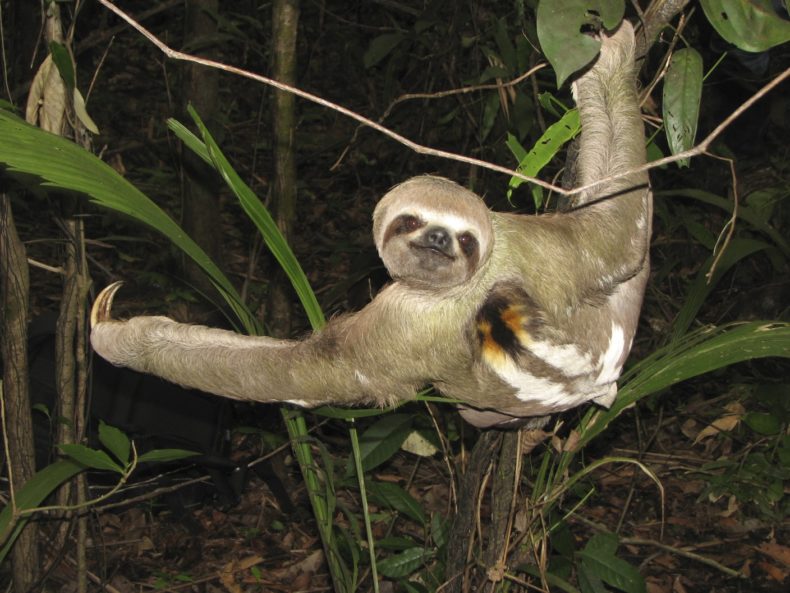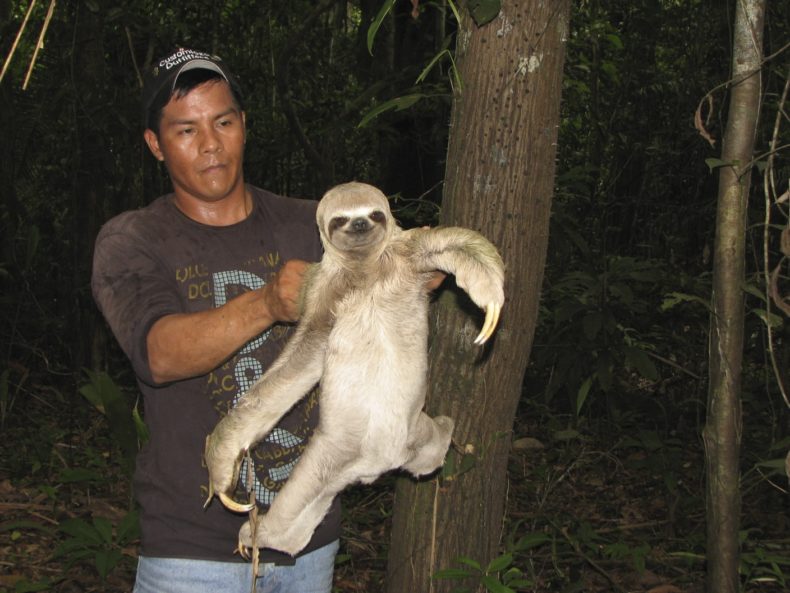This is the first post in LWON‘s 4,729th annual Snark Week, a tribute to the Discovery Channel’s Shark Week, filled with what we hope is an equal amount of truthfulness, credibility, and creativity. If you happen to notice we’ve written about sloths before, you may consider the following a timely and urgent update — less a blog post than a tornado warning.
 The National Safety Office (NSO) is issuing a Code 2 advisory covering all species of sloths (class Mammalia, order Pliosa, families Megalonychidae and Bradypodidae). This alert level indicates that the animals pose a significant risk of injury, illness, and death for travelers, forest workers, and other individuals who may come into contact with them.
The National Safety Office (NSO) is issuing a Code 2 advisory covering all species of sloths (class Mammalia, order Pliosa, families Megalonychidae and Bradypodidae). This alert level indicates that the animals pose a significant risk of injury, illness, and death for travelers, forest workers, and other individuals who may come into contact with them.
Sloths are arboreal herbivores that inhabit parts of Central and South America. Their benign, almost friendly appearance belies their ferocious nature and encourages foolhardy behavior, such as attempts to pet or cuddle these dangerous animals. At the very least, touching a sloth exposes the individual to the large number of bacteria and fungi that inhabit its fur, including potential pathogens. Because a sloth’s pelt is often coated with algae and provides a home to numerous ticks, mites, and other arthropods, contact with it has been reported to trigger nausea, vomiting, and expressions of disgust. Immediate hand washing may reduce the odds of developing these symptoms, but to prevent contamination the NSO advises individuals who have handled a sloth to promptly immerse themselves in surgical disinfectant.
 Sloth encounters most often turn tragic when the animals attempt to defend themselves with their claws, which can grow up to four inches long and be razor-sharp. A slash from a powerful adult sloth can easily sever the carotid artery, gouge out an eye, or slice open the abdominal cavity. Even wounds that barely penetrate the skin could transmit rabies, which is common in the rain forests where sloths live because of the presence of vampire bats. Although there are no reported cases of humans being disemboweled by rabid sloths, that perfect safety record is no doubt the result of good luck and the relative rarity of human-sloth interactions.
Sloth encounters most often turn tragic when the animals attempt to defend themselves with their claws, which can grow up to four inches long and be razor-sharp. A slash from a powerful adult sloth can easily sever the carotid artery, gouge out an eye, or slice open the abdominal cavity. Even wounds that barely penetrate the skin could transmit rabies, which is common in the rain forests where sloths live because of the presence of vampire bats. Although there are no reported cases of humans being disemboweled by rabid sloths, that perfect safety record is no doubt the result of good luck and the relative rarity of human-sloth interactions.
As more and more people intrude on the sloth’s rain forest home, the NSO cautions individuals to be aware of another hazard: sloths as projectiles. Much as a tortoise dropped by an eagle killed the ancient Greek playwright Aeschylus, a sloth plummeting from the trees could crush the skull of an unsuspecting person, dislocate the cervical vertebrae, or cause severe lacerations.
Naturally, you are worried about the becoming a victim of a sloth. But you can dramatically reduce your risk with a few simple steps. Remember that the odds of a fatal sloth attack drop almost to zero if you avoid the natural range of the living sloth species. The NSO suggests that anyone who wants to explore the rain forest should consider less dangerous alternatives, such as watching nature programs on TV or visiting sites on the Internet.
Anyone who must travel to areas where sloths may be present should know a few safety rules. If you do encounter a sloth on the ground, don’t panic. Turn around and hurry in the opposite direction; the animal is unlikely to pursue you. If retreat is not an option, you may be able to scare the sloth away by jumping up and down and waving your arms—while maintaining a safe distance. Chances are the sloth will move off within 24 to 48 hours. At present, the NSO cannot recommend any of the commercial sloth repellents, such as Sloth-B-Gone, because of insufficient field testing.
The NSO hopes that its educational efforts will finally lead to public recognition of the dangers of sloths. This advisory remains in effect until June 24, 2023.
_________
Mitch Leslie is a science writer living in the rain-soaked environs of Portland, Oregon. His work usually appears in Science magazine. He’s been following sloth safety issues since 2011.
_________
Photos of sloth, and sloth with person keeping a close eye on sloth: by Mitch Leslie
Thank you Mitchell for bringing this overlooked menace to our notice. What you don’t mention is that sloths are equally able to attack our children. So, in a way, if you are not afraid of sloths, you hate children. On a totally different note, I’m still waiting on FDA approval for my patented SlothBlock spray. Way more effective than Sloth-B-Gone.
Thanks for the post, yet another reason to avoid going to South America. But, what about the Australian equivalent, the cuddly Qantas mascot, the Koala, or as those in the know call them “Drop Bears”?
Oh dear, David. Oh dear. Oh my goodness. Well then. Next year’s Snark Week for sure.